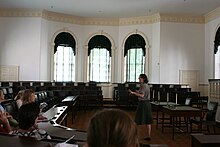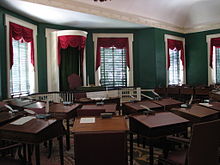Congress Hall
| Congress Hall | |
|---|---|
 Exterior view of the Congress Hall |
|
| Data | |
| place | Philadelphia , Pennsylvania |
| Construction year | 1789 |
| Coordinates | 39 ° 56 '56.8 " N , 75 ° 9' 2.5" W |
The Congress Hall is a building near the intersection of Chestnut and 6th Streets in Philadelphia ( Pennsylvania ) that on 6 December 1790 to 14 May 1800, when the seat of the Congress of the United States served. While Congress Hall was serving as the United States' Capitol, three new states were admitted to the confederation: Vermont, Kentucky, and Tennessee; the Bill of Rights of the Constitution of the United States have been ratified; and the inauguration of two Presidents, George Washington and John Adams, took place there.
The Congress Hall was restored to its original appearance in 1796 throughout the 20th century. The building, located in Independence National Historical Park , is now managed by the National Park Service and is open to public tours. The Congress Hall is not to be confused with the Independence Hall , which is next door.
background
Philadelphia served as the capital of the United States during and after the War of Independence . Independence Hall, right next to Congress Hall, was the venue for the Continental Congress until the Pennsylvania Mutiny in 1783 . Since it did not make the government of Pennsylvania, to protect the Congress before the angry mob of mutineers, he was forced to Princeton ( New Jersey move). The capital was then Annapolis ( Maryland ) from November 1783 , Trenton (New Jersey) from November 1784 and finally New York City from January 1785 . The MPs did not return to Philadelphia until the Philadelphia Convention in 1787; New York City remained the official capital even during the Philadelphia Convention. The Congress Hall, designed by architect Samuel Lewis, was originally intended to serve as the Philadelphia County courthouse; Construction began in 1787 and was completed two years later.
Temporary Capitol
Article 1, paragraph 8 of the US Constitution grants Congress the power to establish a capital district to serve as the capital of the United States. After the constitution was ratified, Congress, which was sitting in New York at the time, passed the Residence Act on July 9, 1790 . This law stipulated that the new capital Washington, DC , was to be built on the banks of the Potomac River between the states of Maryland and Virginia . Robert Morris , Senator for Pennsylvania, convinced Congress to return to Philadelphia while the new capital was being built. As a result, Congress made Philadelphia the temporary capital city for a period of ten years.
In an effort to convince Congress to leave the capital in Philadelphia, the city began building a new presidential palace on 9th Street and expanding the courthouse to create the Congress Hall. After the return of Congress to Philadelphia on December 6, 1790, the first floor was converted into a boardroom for the United States House of Representatives and the first floor was the boardroom for the Senate. Despite their efforts to build new buildings for federal government use, the city's citizens failed to convince Congress to amend the Residence Act and make Philadelphia the permanent capital. The Congress Hall served as the Capitol until the government moved to Washington DC on May 14, 1800.
Interior
The interior of the plenary hall on the first floor was kept quite simple, consisting of mahogany tables and leather chairs. The room housed 106 MPs from 16 states: the 13 original states and the three new states Vermont (1791), Kentucky (1792) and Tennessee (1796). In 1796 the room was restored to its original state. The first floor, reserved for the Senate, was more ornate and had heavy red curtains. Up to 1796 there were 32 desks in the hall, which were very similar to the desks used in today's Senate Hall; 28 of the desks in the Congress Hall are original. Portraits of Louis XVI hang in the adjoining commission rooms . and Marie Antoinette , given to the United States by the French monarch after the American Revolution. On the ceiling there is a fresco of a bald eagle holding the traditional olive branch, a symbol of peace. There is also a stucco medallion in the shape of a sun on the ceiling, 13 stars stand for the 13 original colonies. The design is reflected in a similar form on the floor. There is a carpet made by William Sprague, a local weaver, showing the coats of arms of all 13 original states. Today's carpet is a reproduction of the original.
legacy
In the nearly ten years that Congress Hall served as the Capitol, it witnessed many historic events including the admission of three new states. The Bill of Rights was ratified there in 1791, the second inauguration of George Washington in 1793 and that of John Adams in 1797. Congress also used the time to introduce the First Bank of the United States , the Federal Mint, and the Department of the Navy . The Jay Treaty , which secured temporary peace with England, was also ratified in Congress Hall in 1796. After Washington DC became the capital, the Congress Hall reverted to the Philadelphia County Courthouse and housed both the state and federal courts during the early 19th century. The Burlington County Courthouse in Mount Holly, New Jersey, also designed by Samuel Lewis, was built on the model of the Congress Hall in 1796.
Restoration and present condition
After being used as a courthouse in the early 19th century, the Congress Hall, like other buildings in the area, fell into disrepair. In 1870, the Pennsylvania government resolved to demolish all buildings around Independence Hall. However, the law was never implemented and was officially repealed in 1895. The Colonial Dames of America , a nongovernmental association, began restoration work in 1896, with their work largely related to the Senate Chamber. In 1900, the Philadelphia branch of the American Institute of Architects (AIA) began a study of the Congress Hall and initiated a fundraising call for a full restoration of the building. After funding was secured, the City of Philadelphia approved the restoration under the supervision of the AIA. When the work was completed the next year, President Woodrow Wilson rededicated the Congress Hall . Additional renovation work was completed in 1934. In 1942, more than 50 civil and patriotic groups met in the American Philosophical Society and formed the Independence Hall Association . The association campaigned for the creation of the Independence National Historical Park , which was first approved by Congress in 1948 and formally established on July 4, 1956. The Congress Hall is now operated by the National Park Service , which offers tours year round. Pre-registrations are not possible, whoever comes first will be served first. On December 2, 2008, President- elect Barack Obama met with the National Governors Association in Congress Hall to discuss the impact of the 2008 economic crisis on the country.
Individual evidence
- ↑ a b c d e f Congress Hall . Independence Hall Association. Retrieved September 7, 2008.
- ↑ a b The Nine Capitals of the United States . United States Senate . Retrieved September 7, 2008.
- ↑ a b c The President's House in Philadelphia . Independence Hall Association. July 4, 1995. Retrieved August 27, 2008.
- ↑ a b Main Street Mount Holly . Mount Holly Main Street Association. Archived from the original on March 7, 2008. Info: The archive link was automatically inserted and has not yet been checked. Please check the original and archive link according to the instructions and then remove this notice. Retrieved October 7, 2008.
- ^ Residence Act: Primary Documents in American History . Library of Congress . September 21, 2007. Retrieved September 23, 2008.
- ^ A b Independence Hall, Congress Hall, Old City Hall . Independence Hall Association. Retrieved September 7, 2008.
- ↑ a b Congress Hall . National Park Service . January 20, 2008. Retrieved September 7, 2008.
- ^ Mount Holly Township Historic Information . Burlington County Government. Archived from the original on June 24, 2006. Info: The archive link was automatically inserted and not yet checked. Please check the original and archive link according to the instructions and then remove this notice. Retrieved October 7, 2008.
- ↑ a b c Independence National Historical Park . National Park Service. December 2, 2002. Retrieved October 7, 2008.
- ↑ Thomas Fitzgerald: Obama says he'll give govs role in bailout , Philadelphia Inquirer . December 2, 2008.
literature
- Russell Frank Weigley, Nicholas B. Wainwright, Edwin Wolf: Philadelphia: A 300 Year History . WW Norton & Company, New York 1982, ISBN 978-0393016109 .

